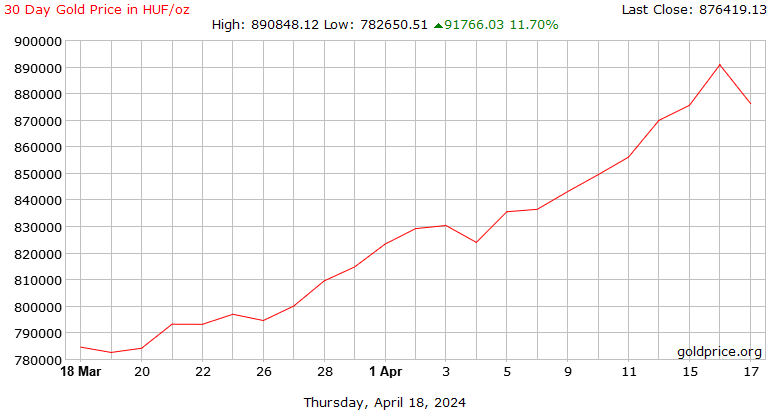Gold Price Hungary
(Hungarian Forint)
Conversion : 1 troy ounce = 31.1034768 grams
Hungarian Forint 24 Hour Spot Gold and Silver Price
Hungarian Forint Gold Price History Charts
To learn about our gold price data
Gold Price Hungary
Hungary is located in Central Europe and its capital and largest city is Budapest. The government of Hungary is a unitary, parliamentary republic and the country is a medium-sized member state of the European Union. Hungary has an approximate population of just under 10 million, and it is a member of various other groups as well such as the United Nations, World Bank and NATO.
The official currency of Hungary is the Hungarian Forint. The forint was previously divisible into 100 smaller currency units called filler, but filler coins are no longer in circulation. The Hungarian Forint was introduced in 1946 in a key step taken to stabilize the nation’s economy following World War II. Although Hungary is an EU member, the nation has not yet made the move to the shared currency, the euro. Such a move could, however, be some time off.
The Hungarian Forint is issued and controlled by the Hungarian National Bank. This bank is the central bank of Hungary, and it is part of the European System of Central Banks. It was established in 1924, replacing the Royal Hungarian State Bank that originally introduced the nation’s currency.
If you are looking to buy gold in Hungary, you will likely see prices quoted in the local currency by the ounce, gram or kilo. Prices may also be available in other key currencies such as U.S. Dollars, euros or Japanese Yen.
Gold production was reportedly first being performed in Hungary during the Roman period. In fact, the country was not a significant producer of gold until a discovery was made in the Garam region. Following this discovery, the nation produced 40,000 to 10,000 ounces per year at its peak. During that period, Hungary was responsible for nearly 80 percent of European gold production and accounted for about a third of global supply.
Modern day Hungary is a leader in several types of mineral production, but it is not a significant producer of gold. Some experts believe, however, that the nation could be sitting on significant gold reserves. There are numerous challenges to further gold mining in Hungary, however, including the environmental impact and the archeological importance of some previous sites.
Hungary’s economy is a high-income mixed economy with a skilled labor force. Hungary’s economy ranks in the top 50 for GDP per capita, and it is export-oriented. The country relies heavily on foreign trade and is a significant exporter. Major areas of industry in the Hungarian economy include food processing, metallurgy, electronics and machinery.
The Hungarian Mint is owned by the National Bank of Hungary. The mint’s business is focused on the production of high quality coins and medals including circulation coinage and commemorative coinage.
If you are looking to acquire as much gold as you can, you may want to stick with gold bullion bars. Cast gold bars, in particular, may offer a significant per-ounce cost savings compared to bullion coins and collectibles. Because of the way these bars are produced, no two cast bars will look exactly the same.















